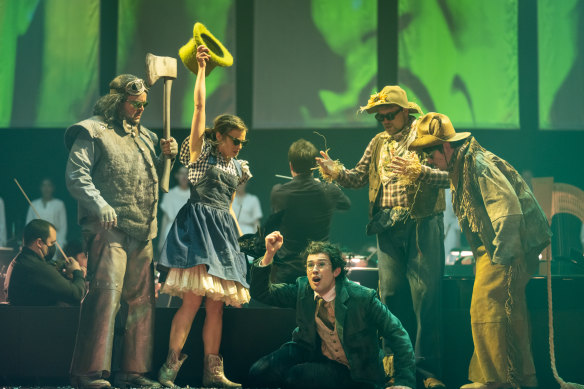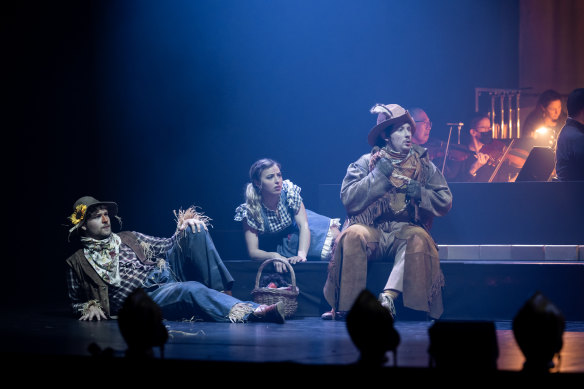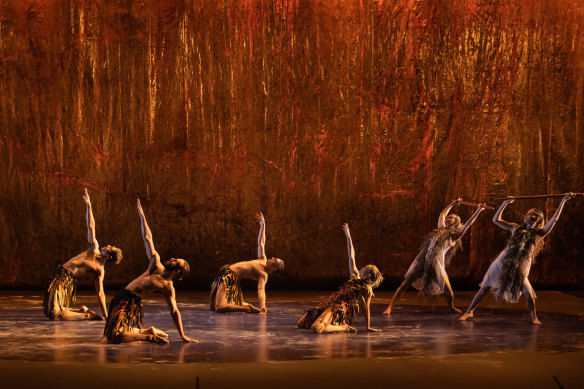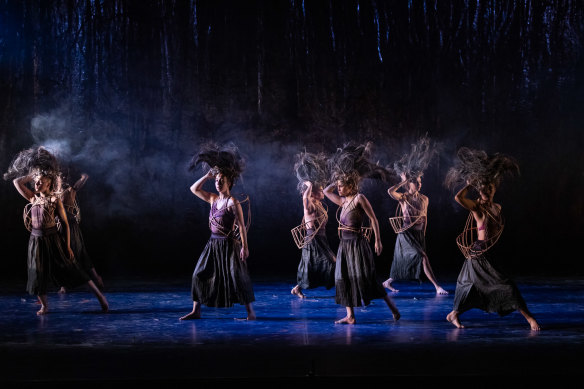Operatic reimagining of beloved story shows there’s no place like Oz
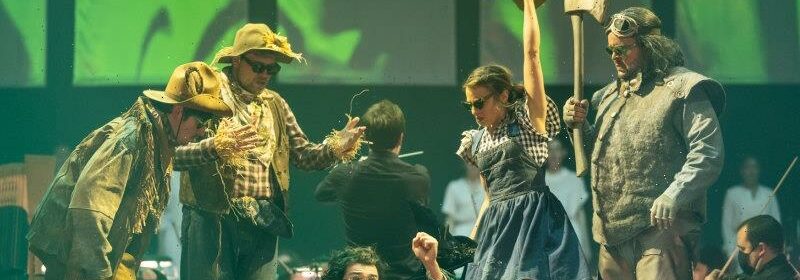
This wrap of reviews for shows around Melbourne an operatic reimagining of The Wizard of Oz and the return of a dance company after a three-year absence.
OPERA
Il Mago di Oz ★★★
Victorian Opera, Palais Theatre, until August 30
Up on a balcony, a figure dressed in green starts an old-fashioned projector spinning, and suddenly the stage bursts into life. On a semi-transparent screen a silent film starts to play. The actors and the set are unfamiliar but the characters are not. There’s a girl, a scarecrow, a man made of metal, and what looks like a lion. Through this screen we can see an orchestra playing, the music swirling and dramatic as a storm begins to build.
Stephen Marsh, Georgia Wilkinson, Tiernan Maclaren, Michael Dimovski and James Emerson star in Victorian Opera’s Il Mago di Oz.Credit:Charlie Kinross
Since L Frank Baum’s Oz The Wonderful Wizard of Oz was released in 1900, the story of Dorothy’s fantastical quest to return home to Kansas has been retold almost countless times on the stage and screen. Il Mago di Oz is the story’s operatic reimagining. First staged in 2016, Saturday night saw Victorian Opera give the production its Australian premiere.
The production leans into the surreal nature of the book that inspired it. The orchestra is centre stage for the entire performance, the action whirling around them like a breeze – or at times a tornado. Chorus members – dressed entirely in white – are deployed to great effect. They are the swelling winds that brought Dorothy to Oz. Projections turn them into sunflowers dotting a field; they become field mice, munchkins, the cult-like citizens of the Emerald City.
Michael Dimovski, Georgia Wilkinson and James Emerson star in Victorian Opera’s Il Mago di Oz.Credit:Charlie Kinross
Throughout the Saturday night performance, the vocals and dialogue suffered from volume issues, but the quality and evenly matched skill of the main cast was readily apparent. Georgia Wilkinson is a sweet and powerful Dorothy, and baritone Stephen Marsh as The Tin Man is a particular highlight. The production is laced with humour – and the surtitles translating the Italian lyrics and dialogue to include the occasional “mate” was well received by the audience.
Composed by Pierangelo Valtinoni with a libretto by journalist Paolo Madron, Il Mago di Oz deftly navigates a difficult line – balancing giving people what they expect from such a beloved and familiar story while also delivering a new and fresh interpretation.
Reviewed by Elizabeth Flux
DANCE
SandSong, Bangarra ★★★
Arts Centre Melbourne, until September 3
The return of Bangarra to Melbourne after a three-year absence is a welcome event, even if this current offering – a story of the Kimberley and Great Sandy Desert regions – is not an outstanding example of what the celebrated Indigenous contemporary dance company can do.
SandSong, Bangarra at Sydney Opera House.Credit:Daniel Boud
This is a relatively short program but the pattern of the narrative is epic, beginning deep in an eternal and uncreated darkness, extending through the turbulent 20th century into the present. It all happens before a vast cloth of gold that glows and glitters and burns.
The work begins with a reflection on the ways in which the energy of the land connects with cycles of life in the bush and the desert for men and women, moving between a sort of contemporary impressionism and learned traditional dances.
The men appear to have the more interesting material: stomping and quivering through a series of strong group designs before moving into a traditional story – executed with eye-catching intensity – about the theft of totemic objects.
The contemporary material performed by the women’s ensemble is rather banal. There is a lot of airy-floaty drifting about, punctuated by an occasional elevated leg. And whatever its inspiration, it fails to suggest a powerful feminine force that connects and flows.
SandSong Bangarra at Sydney Opera House.Credit:Daniel Boud
In the third act, visions of desperate people in chains are accompanied by the babble of an auctioneer at a cattle market. It’s very lurid and sensational and does not confront the special cruelties by which the Indigenous populations of the Kimberley were pressed into service.
In act four – the pastoral industry having given way to the mining industry – there’s a fine duet featuring Beau Dean Riley Smith and Lillian Banks, full of low crouches and poignant clutching. He staggers like a man who has lost his place in the world. She supports and reorientates him.
The show finishes with a beautiful series of dances for the whole ensemble. Bodies shimmer darkly as they flip and fold together. It’s the spectacle of a community gathering back its people and its knowledge. Behind them, the gleaming cloth – all red and orange – suggests sunset or the dawning of a new day.
Reviewed by Andrew Fuhrmann
A cultural guide to going out and loving your city. Sign up to our Culture Fix newsletter here.
Most Viewed in Culture
From our partners
Source: Read Full Article
